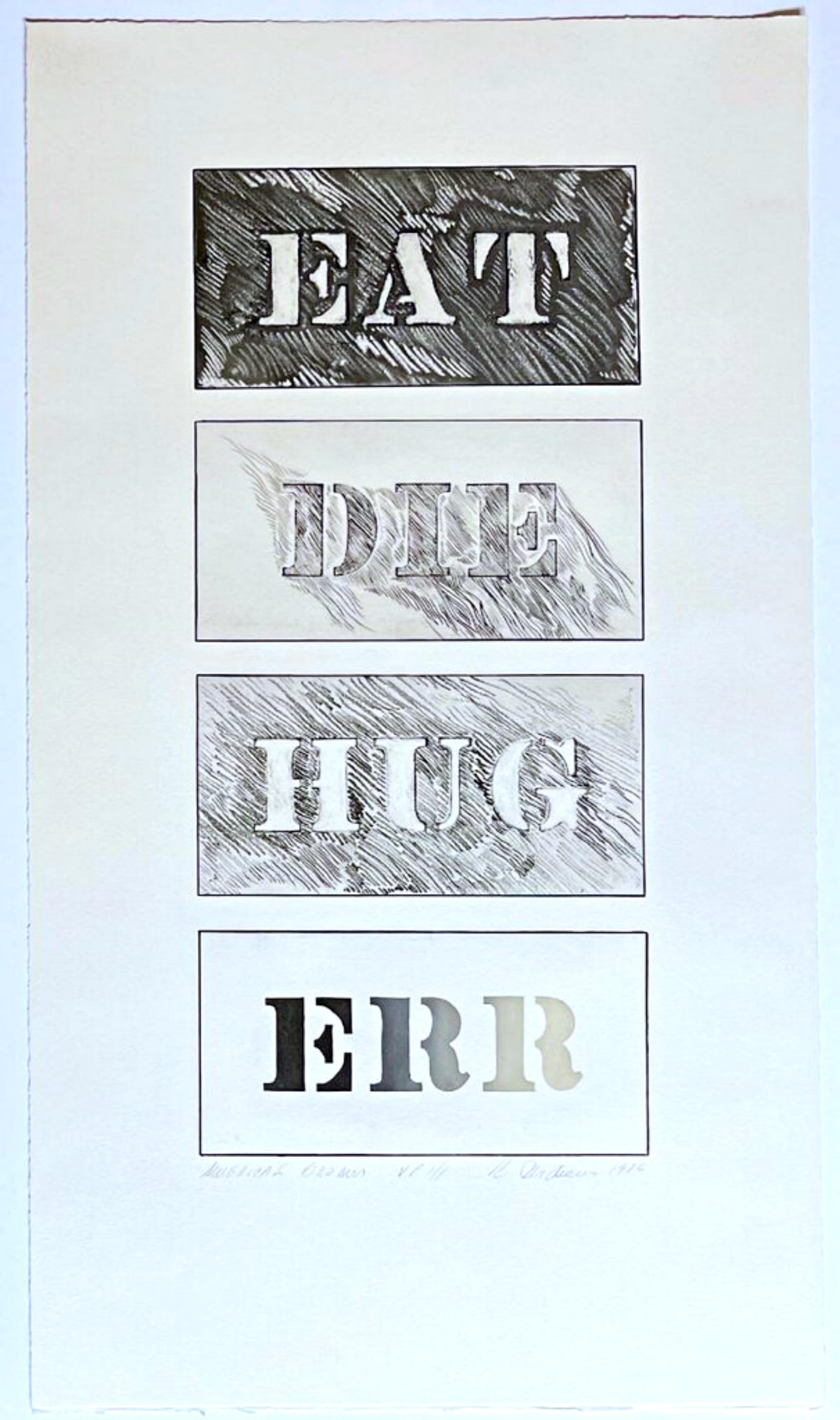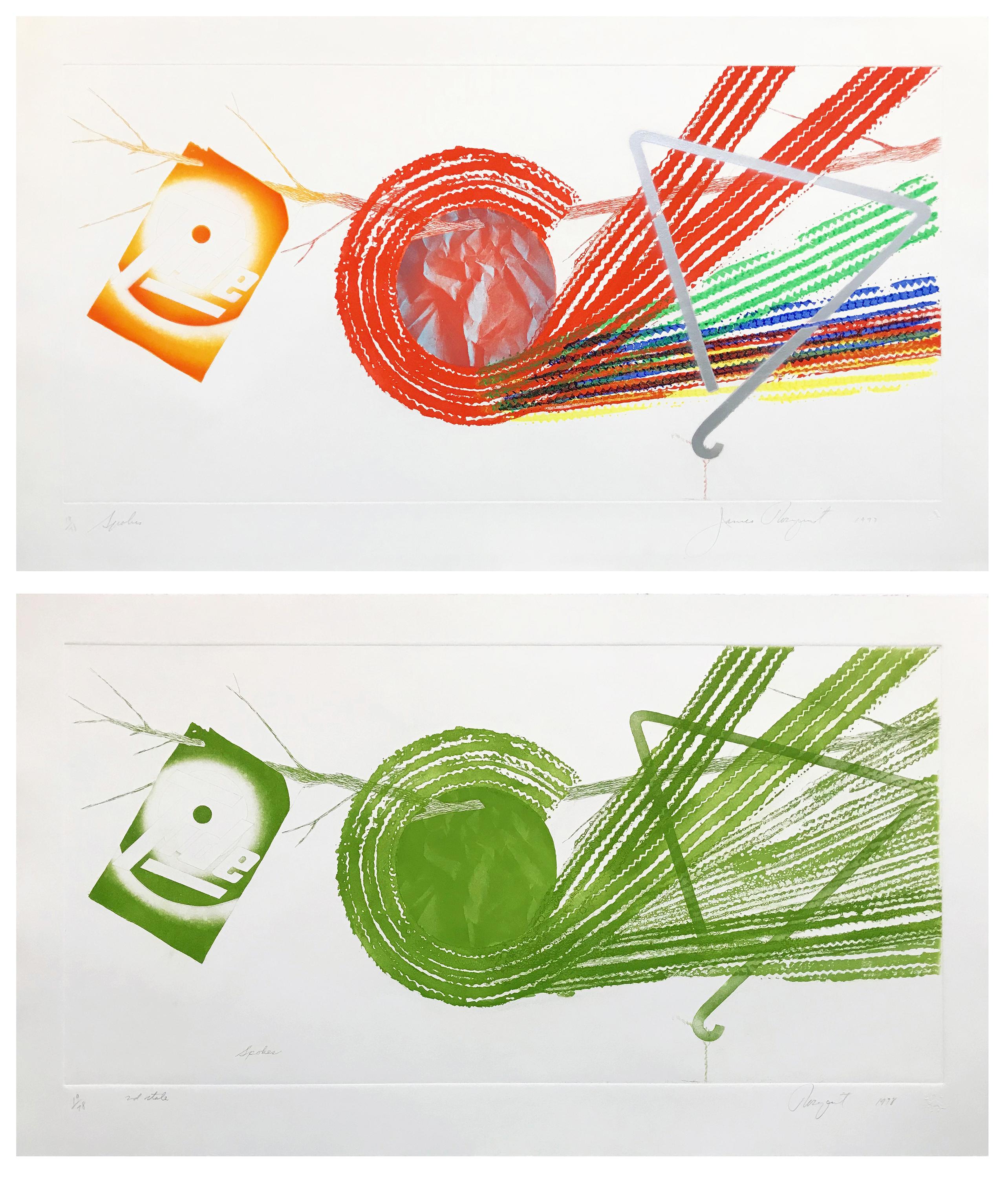James RosenquistTide1979
1979
About the Item
- Creator:James Rosenquist (1933, American)
- Creation Year:1979
- Dimensions:Height: 22.75 in (57.79 cm)Width: 39.75 in (100.97 cm)Depth: 0.01 in (0.26 mm)
- Medium:
- Movement & Style:
- Period:
- Condition:
- Gallery Location:San Francisco, CA
- Reference Number:
James Rosenquist
Although he insisted that he and his fellow Pop artists developed their art-making styles independently, American painter James Rosenquist belonged at the table with Andy Warhol and Roy Lichtenstein.
Known for his distinctive use of visual montage, Rosenquist produced large, vibrantly colored tableaux marked by fragmentation and overlap. He often employed familiar motifs and objects drawn from popular contemporary culture — hot dogs, lipstick tubes, American flags — which he manipulated to form disorienting compositions whose constituent elements are nearly unrecognizable.
Born in North Dakota to Swedish parents, Rosenquist was encouraged to pursue painting by his mother, who was also an artist. He studied painting for two years at the University of Minnesota, but dropped out at the age of 21 to attend the Art Students League in New York on a scholarship. A job as a billboard painter in the late 1950s set him up to pursue his signature style, which borrowed its bold graphics and remixed kitschy aesthetic from the visual vocabulary of advertising. Works like Flamingo Capsule (1983) embody his trademark visual dissonance, drawing cigarette-ad motifs into conversation with stripes from the American flag and aluminum foil wrappers.
In addition to enormous paintings, Rosenquist created drawings, prints and collages. The 2011 lithograph The Memory Continues but the Clock Disappears is a montage of melting clocks and confetti, all submerged in a pool of water. While wryly hinting at the inevitability of decay and deterioration — suggesting that life is a ticking clock — the composition also alludes to Salvador Dalí's signature motif, the defining symbol of Surrealism. Such compositions demonstrate how Rosenquist masterfully combined seemingly incongruous elements into a harmonious and poetic whole.
Find James Rosenquist art today on 1stDibs.
- ShippingRetrieving quote...Ships From: San Francisco, CA
- Return PolicyA return for this item may be initiated within 7 days of delivery.
- Swing ScreenBy James RosenquistLocated in San Francisco, CAThis artwork titled "SWing Screen" 1979 is an original colors etching with aquatint on Pescia Italia paper by renown American artist James Rosenquist, 1933-2017. It is hand signed, d...Category
Late 20th Century Pop Art Abstract Prints
MaterialsEtching, Aquatint
- Star Leg (2nd State)By James RosenquistLocated in San Francisco, CAArtist: James Rosenquist (1933-2017) Title: Star Leg (2nd state) Year: 1979 Medium: 1 color etching Edition: 78, plus proofs Sheet Size: 22.75 x 40 inches Plate size: 17.75 x 35.5 in...Category
1970s Pop Art Abstract Prints
MaterialsPaper, Etching
- "Curvy Brushstrokes" Large etching with aquatint, framedBy Sol LeWittLocated in San Francisco, CAThis artwork titled "Curvy Brushstrokes" 1997 is a colors etching with sugar lift aquatint on Somerset textured white paper by renown artist Sol (Solomon) LeWitt, 1928-2007. It is hand signed and numbered 1/15 in pencil by the artist. The image size is 29.90 x 39.90 inches, paper sheet size is 40.5 x 49.80 inches, framed size is 43.75 x 53 inches. Published by Crown Point Press, San Francisco, printed by Dana Sywulak, assisted by Dena Schneleit, Mary Andrews and Case Hudson at Crown Press, San Francisco. Referenced and pictured in the artist's catalogue raisonne, plate #1997.07. Custom framed in a wooden black frame, floated on white backing, with white spacer. It is in excellent condition, the frame has minor very small restorations, practically invisible. About the artist: Known for his modular white cube sculpture, geometric drawings and abstract design paintings including many wall paintings that took teams of people to execute, Sol LeWitt was a major promoter of dominant post World War II Conceptualism and Minimalism. He used geometric shapes and lines to challenge his viewers, and sometimes they seemed logical and other times they seemed to have no basis in either reason or reality. Although he was highly active in New York City, he shied away from any semblance of art celebrity life style and spent much of his later life working from his home and studio in Chester, Connecticut. At the beginning of his career when he was gaining notoriety, conservative critics panned him fiercely. Seeking to get away from the frenetic activity of the New York art scene, he went to Spoleto, Italy in the 1980s and remained there for many years. The influence of Italian culture seemed to lend a new opulent quality to his work, and also the launching of his wall paintings, which he called drawings even though they were done with acrylic paint. "He began making colored flagstone patterns, spiky sculptural blobs and ribbons of color, like streamers on New Year's Eve, often as enormous decorations for buildings around the world. It was if he had devised a latter-day kind of Abstract Expressionism . . ." (Kimmelman) Of his personal modesty it was written: "He tried to suppress all interest in him as opposed to his work; he turned down awards and was camera-shy and reluctant to grant interviews. He particularly disliked the prospect of having his photograph in the newspaper." (Kimmelman) Sol LeWitt was born in Hartford, Connecticut to Russian immigrant parents. His father, a doctor, died when Sol was age six, and he and his mother then went to live with an aunt in New Britain, Connecticut. His mother encouraged his art talent, and enrolled him in classes at the Wadsworth Atheneum. LeWitt's subsequent residence in Chester, after he was a well-known artist, was near the Atheneum, and he became a strong supporter of that institution including the securing of a long time loan to it of a highly prestigious private collection of modern art. LeWitt earned a B.F.A. degree from Syracuse University in 1949, and then was drafted in the Korean War. His special assignment was making posters for the Special Services. From 1955 to 1956, he worked as a graphic designer for architect I.M. Pei, who was beginning his career. He also did pasteups for Seventeen magazine...Category
Late 20th Century Abstract Abstract Prints
MaterialsEtching, Aquatint
- "Centre Noeuds" planche #3By Roberto MattaLocated in San Francisco, CAThis artwork titled "Centre Noeuds" plate #3 1974, is an original color etching with aquatint on Japan nacre paper by renown Chilean artist Roberto Sebastian Matta, 1911-2002. It is ...Category
Mid-20th Century Surrealist Abstract Prints
MaterialsAquatint
- "Centre Noeuds" planche #8By Roberto MattaLocated in San Francisco, CAThis artwork titled "Centre Noeuds" plate #8 1974, is an original color etching with aquatint on Japan nacre paper by renown Chilean artist Roberto Sebastian Matta, 1911-2002. It is ...Category
Mid-20th Century Surrealist Abstract Prints
MaterialsAquatint
- "Centre Noeuds" planche #10By Roberto MattaLocated in San Francisco, CAThis artwork titled "Centre Noeuds" plate #10, 1974, is an original color etching with aquatint on Japan nacre paper by renown Chilean artist Roberto Sebastian Matta, 1911-2002. It i...Category
Mid-20th Century Surrealist Abstract Prints
MaterialsAquatint
- American Dream (EAT / DIE / HUG / ERR) (Sheehan 136) UNIQUE Proof Love Food LifeBy Robert IndianaLocated in New York, NYRobert Indiana American Dream (EAT / DIE / HUG / ERR) (Sheehan, 136), 1986 Hard and soft-ground etching, aquatint, drypoint and stencil on white Arches paper 37 inches × 21 inches ...Category
1980s Pop Art Abstract Prints
MaterialsMixed Media, Drypoint, Etching, Aquatint, Stencil
- Zapata-Tiempo, signed/N by both Ed Ruscha and Billy Al Bengston, made in SpainLocated in New York, NYEd Ruscha, Billy Al Bengston, Ed Ruscha and Billy Al Bengston Zapata-Tiempo, hand signed by both Ed Ruscha and Billy Al Bengston, 1988 (Engberg & P. 168), 1988 Color etching and aqua...Category
1980s Pop Art Abstract Prints
MaterialsEtching, Pencil, Mixed Media, Aquatint
- SPOKESBy James RosenquistLocated in Aventura, FLHand signed, dated, numbered and titled by the artist. Etching and aquatint on Pescia Italia paper. Edition of 78. Published by Multiples, Inc. Sheet size 23 x 40 inches. Frame si...Category
1970s Pop Art Abstract Prints
MaterialsEtching, Aquatint
- Untitled (SFE-057)By Sam FrancisLocated in San Francisco, CAOriginal aquatint printed in 20 colors from 4 steel-faced copper plates on BFK Rives wove paper Hand-signed in pencil in the margin lower right Sam Francis. A superb artist’s proof...Category
1990s Pop Art Abstract Prints
MaterialsAquatint
- SPOKES AND SPOKES: 2 STATEBy James RosenquistLocated in Aventura, FLSpokes (1977) and Spokes: 2 State (1978). Each hand signed, dated, numbered and titled by the artist. Both prints have matching editions. Etching and aquatint on Pescia Italia paper....Category
1970s Pop Art Abstract Prints
MaterialsEtching, Aquatint
- Sunscrapers, Geometric Abstract Aquatint Etching by Patrick HughesBy Patrick HughesLocated in Long Island City, NYArtist: Patrick Hughes, British (1939 - ) Title: Sunscrapers Year: 1980 Medium: Aquatint, signed and numbered in pencil Edition: 24/90 Size: 36 x 29.25 inchesCategory
1980s Pop Art Abstract Prints
MaterialsAquatint




